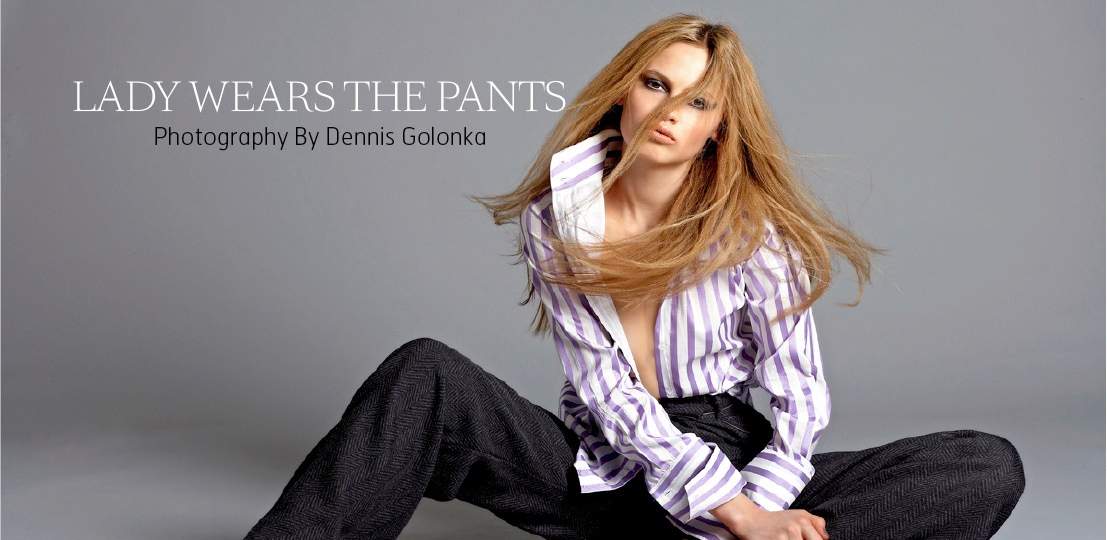
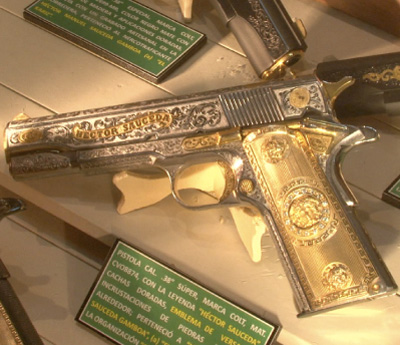
Photography by John Dickie


When a gram of coke is purchased in North America, much of the profit ends up blood-stained in the back pocket of a Mexican druglord (or more precisely, in one of his crates of greenbacks in a warehouse somewhere). And what will the druglord spend it on? Weapons and gold, mostly.
On the seventh floor of army headquarters in Mexico City, some of the kingpins’ personal treasures are on show in a curious little bazaar of narco items called the Museo de Enervantes (Narcotics Museum). It’s not open to the public — it’s designed to complement the training of troops in the war on drugs, to help them get to know the enemy better — but PLANET managed to sneak inside and take a peek.
On show is bounty captured from gangster safe houses, or culled from their cold, dead bodies. The permanent collection is truly astounding to behold: like a Gulf cartel boss’ cache of gold-plated, diamond-encrusted Colt pistols, elaborately engraved with initials, signatures, and pre-Colombian motifs. One has a Versace logo, though I doubt Gianni knew much about it. There’s even a solid silver AK-47, which is completely useless as a weapon — it starts to melt after three or four rounds are fired.
The army says all the guns were custom decorated in the US and smuggled into Mexico along with all the other artillery imported by the cartels (samples of which are also on show in the museum: anti-tank 50-caliber Barrett guns, grenade launchers, bazookas). It’s the old adage: while the drugs flow north, the weapons and cash flow south.
(more…)
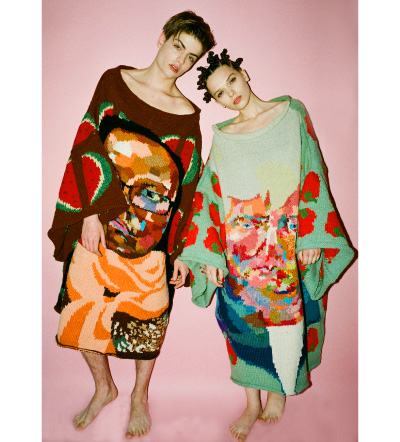

At least politically speaking, 2009 has been a pretty surreal year: America’s first black President smokes cigarettes on the White House lawn, NASA found ice on the moon just a few days ago, and perpetually prepubescent Ashlee Simpson somehow gave birth. Perhaps it’s the ever-bizzaro cultural climate that’s causing fashion designers, like rising Chinese star Du Yang, to embrace their more eccentric talents.
Unlike some of her peers, Du Yang, who graduated last year from Central Saint Martins, gets her potency as a surrealist designer from the cheerful, even comical, approach she brings to a design tradition dominated by the dark and gloomy. Fellow surrealists Junya Watanabe, Rei Kawakubo, Victor & Rolf, and Alexander McQueen tend to concoct ominous and often sinister visions. But Yang’s signature blend of cartoony outlandishness and trompe l’oeil abstraction is more likely to make a person wonder if they dozed off at the computer screen than question the nature of good versus evil.
Yang’s latest collection, It is a Dream in Colors, takes inspiration from the designer’s “spiritual journey to India,” which apparently included (if her chunky knit textiles are anything to go by) a surfeit of watermelons, strawberries, eyeglass-wearing gurus, bumblebees, and cornrows (the hairstyle — not the farming technique).
(more…)
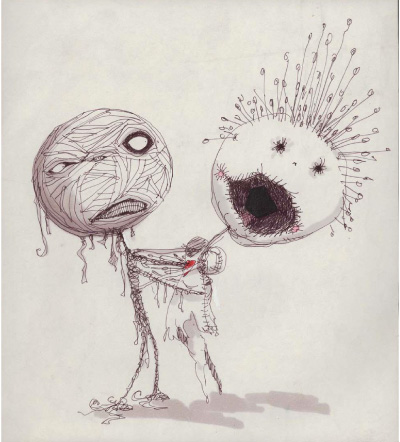
Meloncholy Death of Oyster Boy, Tim Burton. Images courtesy of The Museum of Modern Art

When Tim Burton, who has been compulsively drawing since the teensy age of five, was in the ninth grade he was granted first prize in a design competition for an anti-littering campaign poster. His art went on public view, whizzing about on the garbage trucks of his hometown of Burbank for the good part of two months. Now, thirty-seven years later, his creations will be displayed at the venerable Museum of Modern Art. The show will include more than 700 drawings, paintings, photographs, storyboards, moving-image works, puppets, maquettes, costumes, and other ephemera from Burton’s childhood to his adult years. Inspired perhaps by last year’s successful Dalí: Painting and Film, the retrospective aims to explore the convergence of film and visual art. Few individuals fit into this mold and the most likely candidate for the next installment is director David Lynch, who, when not working on one of his I-dare-you-to-deconstruct-this-narrative films, can be found in his art studio, attacking a canvas with a dollop of paint. But as a follow-up to Dalí, Burton makes more sense. Whereas Lynch operates in the realm of abstraction, Burton, like Dalí, is a fan of the surreal (in fact he’s considered a Pop Surrealist) and, to boot, both have worked with Disney — though to frustrating results. The cartoon that Dalí began creating for the studio in 1946 was swiftly abandoned and a short segment of it was only re-envisioned from storyboards many years after the artist’s death. Fresh from an animation degree at the California Institute of Fine Arts, Burton was hired by Disney and remembers his stint there as being as tedious as an assembly line job.
(more…)
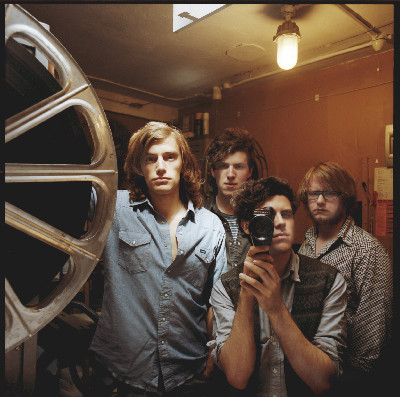
Photography by Jon Bergman

“This is the last song that I write while still in love with you,” Charlie Fink sings on “Blue Skies”, one of many tracks that narrates the end of love from his band’s The First Days of Spring, a concept album of sorts for the brokenhearted. Named after Noah Baumbach’s 2005 film The Squid and the Whale, this London quartet mixed Fink’s downtrodden voice, which recalls Will Oldham, with delicate plucks and pianos throughout their headlining set, exuding a rustic aura of Americana that belies their British background. Much like the band’s cinematic namesake transformed from a quiet melodrama to a modest epic, the album’s title track (streamed below) morphs spare guitars into a climactic swell of violins and distortion.
Audio clip: Adobe Flash Player (version 9 or above) is required to play this audio clip. Download the latest version here. You also need to have JavaScript enabled in your browser.
Buy this at iTunes.

Gestalten Books

You have to wonder if tea tastes better when sipped in the Too-High Teahouse outside Chino City in Nagano, Japan. It’s a small, whimsical building supported by two chestnut tree trunks. The altitude is meant to have a calming effect on guests. The teahouse’s style is what you could call rustic chic. Or woodsy eclecticism. It’s featured in Arcadia: Cross-Country Style, Architecture and Design (Gestalten; $75), a coffee table book about recent buildings and furniture which are surrounded in, and/or inspired by, nature. The book also showcases faux-rustic bowls and utensils, making some sections seem like a housewares catalog for affluent dwarves. (Dutch designer Jo Meesters’s pitchers made of paper pulp and resin are the best of that group.)
(more…)
Check out this video of a bus ride through a forest fire in Queensland, Australia, set brilliantly to Tchaichovsky. Full-screen mode recommended.
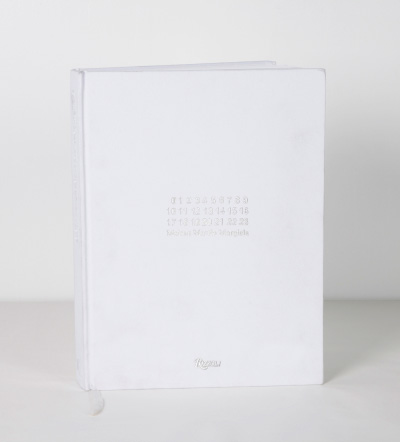
© Maison Martin Margiela by Maison Martin Margiela

Last year, the iconic Belgian designer Martin Margiela celebrated the twenty-year anniversary of his fashion house during his runway show in Paris. One person conspicuously absent from the celebration was Margiela himself. The designer is as notorious for his adamant refusal to be photographed and interviewed, as he is for his innovative work. One can hardly underestimate Margiela’s influence on fashion. From revealing tailoring techniques by deconstructing garments to his quirky shows, like the one held in a candle-lit abandoned Parisian metro station, he has consistently subverted fashion’s conventions. Margiela is a thinking person’s designer — his work is cerebral and methodical. Whether through the subtlety of carefully misplaced seams or the ostentation of blown-up proportions, he forces you to see the clothes in a new light.
Maison Martin Margiela (Rizolli, $100), chronicles the Belgian’s career in its 368 large format pages, full of rare images. The pure white linen cover of the book epitomizes Margiela’s approach to fashion — the garment should speak for itself and not be overshadowed by the designer’s ego. Several essays and letters from contributors such as Jean-Paul Gaultier (with whom Margiela got his first job), Susannah Frankel, and Vanessa Beecroft punctuate the lush photography. The photos depict every important aspect of Margiela’s carefully constructed world, from individual garments to his pointedly unglamorous boutiques.
(more…)
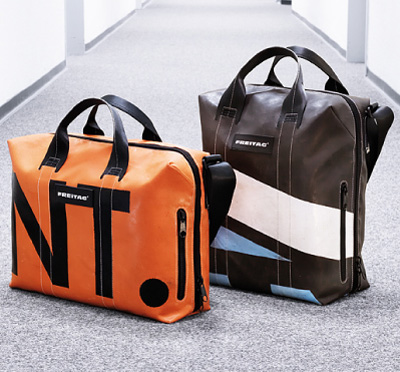

Zurich-based Freitag has just added two new messenger bag styles to its collection of industrial accessories: the F76 Leo bag (for 13” laptops) and the F77 Ben bag (for 13” and 15” laptops). Each unisex style is available in eighty different colorways, and the bags’ versatile design allows the user to carry it as a tote, a shoulder bag, or a crossbody messenger bag. Like the label’s other styles, the boldy-colored Leo and Ben are handmade from used seatbelts and truck tarpaulins. They continue Markus and Daniel Freitag’s legacy of durable, water-resistant messenger bags. Freitag’s longtime dedication to repurposing materials will appeal to the eco-conscious customer, while the new bags’ efficient shape and size will please computer-users from bloggers to businessmen. Great bags for bicyclists and commuters, using the Leo or the Ben is a reliable and trendy way to take your work home with you.
(more…)
Zig-Zag barchan dunes, Uruq al Mutaridah, Saudi Arabia (Photography by George Steinmetz)
(more…)






 Facebook
Facebook Permalink
Permalink Digg
Digg Reddit
Reddit LinkedIn
LinkedIn StumbleUpon
StumbleUpon Tumblr
Tumblr




